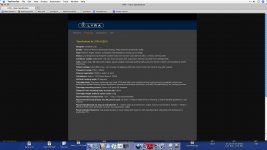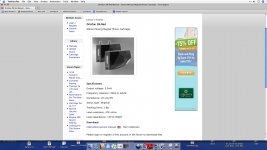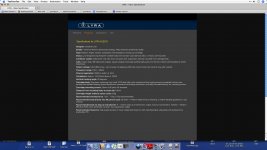Jan, why do you bother with quality audio? You seem to say that nothing matters anymore. Why try to tell us that we can't hear what we hear on a regular basis? Of course, some things can be ignored, like the absolute fidelity of elevator music, but there ARE audio enthusiasts out there who revel in the sonic differences between audio equipment, and even obscure things like 'absolute polarity'. I never did, but I worked for decades with those who could easily point it out.
Mid fi is already out there, let's go toward even better musical reproduction!
Mid fi is already out there, let's go toward even better musical reproduction!
They get short changed anyway, nothing to do with vinyl, simply that typical programme material spectrum roughly follows a 1/f amplitude law. So high frequency content is typically naturally of low amplitude in programme material.If you do the de-emphasis in analog don't the highs get short changed on bits?
You seem to say that nothing matters anymore.
I missed his having said that. Could you point out where?
The mismatch of the week:
An Ortofon Red MM and an SME309 tonearm. $100 for the cartridge, $2400 for the arm. Maybe a better cartridge would have a lower compliance, and raise the resonant frequency to something more appropriate.
An Ortofon Red MM and an SME309 tonearm. $100 for the cartridge, $2400 for the arm. Maybe a better cartridge would have a lower compliance, and raise the resonant frequency to something more appropriate.
Attachments
Last edited:
''He appears to say'' is that any clearer, SY?
Yes. Don't expect people to defend what the voices in your head are telling you. IMO, it's more useful to engage with what people actually say.
I have finally come to a conclusion about adding a hi pass filter to an audio stage.
My recommendation is:
IF you are using a MC cartridge (with modest compliance) and a good (robust, but low mass) tonearm, then run all out! You only have to worry about DC offset.
However, IF you are using a typical MM cartridge, like the Ortofon Red (that looks like a heck of a deal, pricewise) and a typical lowish cost tonearm, then you probably will get an advantage from adding a simple hi pass, at minimum and even more rolloff in extreme cases. However, you will not get the BEST overall performance from the record, or the music. Just sound that you can live with. Bass will be affected, IM will still be added by the stylus motion, etc., but listenable is what Jan seems to be concerned about, not all-out performance.
My recommendation is:
IF you are using a MC cartridge (with modest compliance) and a good (robust, but low mass) tonearm, then run all out! You only have to worry about DC offset.
However, IF you are using a typical MM cartridge, like the Ortofon Red (that looks like a heck of a deal, pricewise) and a typical lowish cost tonearm, then you probably will get an advantage from adding a simple hi pass, at minimum and even more rolloff in extreme cases. However, you will not get the BEST overall performance from the record, or the music. Just sound that you can live with. Bass will be affected, IM will still be added by the stylus motion, etc., but listenable is what Jan seems to be concerned about, not all-out performance.
The attachment is a good example of specification. I wish more manufacturers would be as comprehensive.The mismatch of the week:
An Ortofon Red MM and an SME309 tonearm. $100 for the cartridge, $2400 for the arm. Maybe a better cartridge would have a lower compliance, and raise the resonant frequency to something more appropriate.
I can see where this is going: optimal filtering for digitization.
Don't get me wrong, I'm agnostic on this and probably push come to shove I'm happy with an analog RIAA of non-obsessive quality. This is an interesting problem I'm exploring all angles for some nerdy fun. All I know is that a few experiments seemed quite viable and for sure I think many would be quite happy with the results.
Last edited:
John,
What I read Jan saying many times is that some people seem to obsess with details that more than likely don't make a real difference to most listeners on a regular basis, What I mean is just as you say you didn't pay much attention to absolute phase others will obsess about that and other things like sub-sonics which many would just take care of with a simple filter cut and others make out like you can't listen to music unless you can create a 16hz fundamental to listen to Pop/Rock music, that is just silly.
I think it is Earl Geddes who argues that phase shift over the frequency response curve is only important in a speaker at the cross-over point while others will argue endlessly that absolute phase integrity is necessary across the entire bandwidth. You have to chose your poison and what is important to your design. I know and understand that you want to do the best that you can with the electronic devices you have, and I say why not if you can do it without causing some other problems or compromises, but to obsess about some of these things is crazy and many can't even agree that you can hear many of these issues talked about.be
ps. Christophe,
Living here in earthquake country I can assure you that the sound of an earthquake does often proceed the actual quaking movements, I have heard earthquakes before they hit, it is weird but the sound gets there before the quake so a lead of the sub-sonics effects in that movie soundtrack may not be that far from reality.
What I read Jan saying many times is that some people seem to obsess with details that more than likely don't make a real difference to most listeners on a regular basis, What I mean is just as you say you didn't pay much attention to absolute phase others will obsess about that and other things like sub-sonics which many would just take care of with a simple filter cut and others make out like you can't listen to music unless you can create a 16hz fundamental to listen to Pop/Rock music, that is just silly.
I think it is Earl Geddes who argues that phase shift over the frequency response curve is only important in a speaker at the cross-over point while others will argue endlessly that absolute phase integrity is necessary across the entire bandwidth. You have to chose your poison and what is important to your design. I know and understand that you want to do the best that you can with the electronic devices you have, and I say why not if you can do it without causing some other problems or compromises, but to obsess about some of these things is crazy and many can't even agree that you can hear many of these issues talked about.be
ps. Christophe,
Living here in earthquake country I can assure you that the sound of an earthquake does often proceed the actual quaking movements, I have heard earthquakes before they hit, it is weird but the sound gets there before the quake so a lead of the sub-sonics effects in that movie soundtrack may not be that far from reality.
Last edited:
I'm not finding a lot of material on the real resolution with 24 bit ADCs, except for the super-slow-dog ones suitable for non-audio use.
Maudio uses AKM, DC coupling required pulling up a pin to turn off the default hi-pass. Just saying a quick experiment with a well recorded LP did not say, "this can't work".
Oh, I think I know your intentions are good, and I am happy to explore all options in general. I'm usually motivated by design challenges more than anything else (until paying work comes in!).Don't get me wrong, I'm agnostic on this and probably push come to shove I'm happy with an analog RIAA of non-obsessive quality. This is an interesting problem I'm exploring all angles for some nerdy fun. All I know is that a few experiments seemed quite viable and for sure I think many would be quite happy with the results.
Did I read somewhere when the approach was first bandied about, that the flat amp + ADC + DSP folks are using a mic preamp design as the amp? If so, room for a better flat amp with lower current noise I would suppose. Not so significant for MC of course.
''He appears to say'' is that any clearer, SY?
Well I thought I tried to make clear what it is I care about. When did I say I don't care about good audio?
You know John, if after 10+ years on this forum I still haven't been able to explain to you what I care about; how I try to delve deep into all the root causes of why we perceive what we perceive, why it is that some people really love ss high feedback amps or why some absolutely swear by high priced, technically incompetent products that to all intends and purposes absolutely mutilate the audio, and everything in between, I don't suppose I can do it in the next few minutes.
Jan
Well I find it 'interesting' that this GD takes such prominence in this application. If, as we seem to think, the object is to cut down on infra sound that does not contribute to the audible illusion, why would the GD of such a filter be audible at all?
I'm not saying GD is not audible in carefully controlled A-B tests, but that's no reason to worry about it.
Jan
Jan,
..... All your questions are answered in the literature. There is plenty of reason given to worry about it. And, there are limits given or bounds to stay within etc.
For the switchable HP filter --- You do not want to improve things in one area and mess it up another way. Seems one ought to be able to take care of both conditions for the HP filter. One way or another.
-RNM
Last edited:
Jan,
I understand your doubts..... but, All your questions are answered in the literature. There is plenty of reason given to worry about it. And, there are limits given or bounds to stay within etc.
You do not want to improve things in one area and mess it up another way.
-RNM
I just would hope that someone of all the cognoscienti here could give me a clear straightforward explanation, but nobody seems to be able to go beyond 'its all in the literature'. Heck, I can prove anything by selecting my literature! (I've done it myself, in a moment of weakness).
In all the humhum about HP GD I ask a simple question, how that jives in the light of cartridge/tonearm resonance at around the same freq. All I get is some flak about linear phase, but no clear answer, one way or another. Rather underwhelming, unfortunately. If I wouldn't know better I might be tempting to think that you guys have no idea either. ;-)
jan
Last edited:
Jan, I must agree that we do not understand each other. I went outside of polite conversation with my question to you, but remember, you accuse me of all sorts of delusion, marketing, etc, along with SY and others. I don't like to be characterized in any way but that I am doing my best, either. So, how about a truce?
(until paying work comes in!).
Luckily I don't have to worry about that anymore, It's become a hobby interest to try and inform DIY'ers.
I just would hope that someone of all the cognoscienti here could give me a clear straightforward explanation, but nobody seems to be able to go beyond 'its all in the literature'.
In all the humhum about HP GD I ask a simple question, how that jives in the light of cartridge/tonearm resonance at around the same freq. All I get is some flak about linear phase, but no clear answer, one way or another. Rather underwhelming, unfortunately. If I wouldn't know better I might be tempting to think that you guys have no idea either. ;-)
jan
me, myself and I have no idea, personally, because I dont follow LP systems that much any more. But I do see a lot about such things when I ask The OZ of Internet GD questions various ways.
The cartridge resonance will create its own issues and GD of its own, as well many other system ways and means. Just as it does in speaker systems resonance(s). But you still want to minimize to the max degree possible ALL the contributors. [ That you have a cartridge to deal with is in itself enough reason to move on to other technologies. IMO. ]
The digital domain and DSP, in particular, can now tackle many things not done easily or at all in analog. LP systems have not been optimized for lowest over-all system distortion when GD and infrafreq noise have not been adequately dealt with to minimize it where ever you can. Just as we do with other distortions and noise. Group-Delay is perhaps one of the last 'real' boogy-man left to tackle in audio.... with significant improved results.
THx-RNMarsh
Last edited:
Luckily I don't have to worry about that anymore, It's become a hobby interest to try and inform DIY'ers.
Finally made it to the Good Life.
Does that mean I will see you in Nepal (re)building houses and homes with me? More need now than ever before. I'll be there after the monsoon rains stop.
-RM
- Status
- Not open for further replies.
- Home
- Member Areas
- The Lounge
- John Curl's Blowtorch preamplifier part II


